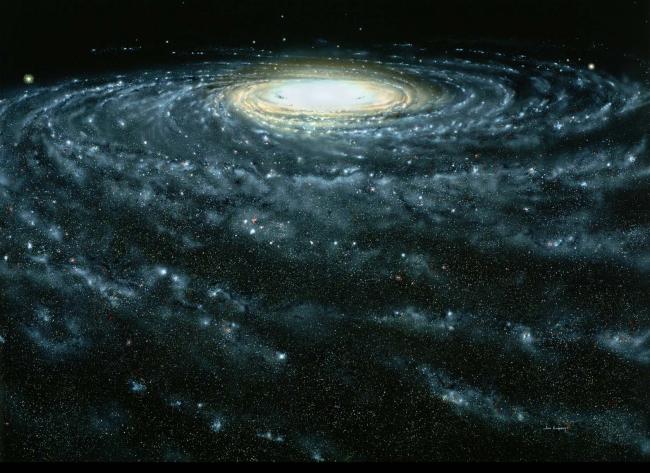
An artist's conception of the Milky Way galaxy. New results have measured the Sun's motion around the galaxy, and the amount of unseen dark matter in the galaxy's halo.
The Sun is located about 25,000 light-years from the center of our galaxy, the Milky Way. Like other spiral galaxies, the Milky Way has a disk with sweeping bands of stars, gas, and dust that curve around the galaxy like the arms of a huge pinwheel. The Sun, Earth, and solar system are located in a spur of material that lies between two of the spiral arms, collectively orbiting around the galaxy about 25,000 light-years from its center about once every two hundred million years.
Because the Milky Way contains copious amounts of dust that blocks our optical views, it is extremely difficult to study the galaxy from our vantage point within the disk. Thus the details of the spiral arms in
our own galaxy are much less certain than is the structure of external spirals such as Andromeda, which is a few million light-years away but sits well above the plane of obscuring dust. Nevertheless, two basic parameters about the galaxy of interest to astronomers are a more precise measurement of the Sun's motion, and the total mass of the galaxy including its so-called "dark matter."
CfA astronomer Daniel Eisenstein has joined with a large team of colleagues to make these measurements by carefully measuring and modeling the motions of 3365 stars located between about thirteen thousand and forty-six thousand light-years from the galaxy's center. By modeling the collective motions of these stars, the scientists can measure the rotation of the galaxy, and the Sun's relative motion as well. Since gravity controls these large-scale rotational effects, the result also fixes the total amount of mass within this region.
The team reported this month that the Sun is zipping along in the galaxy with a rotational velocity of 242 kilometers/second (plus or minus a few percent). The total mass of dark matter in the volume is about 800 billion solar masses, about thirty times more than the total mass of the galaxy in stars and gas. Both of these values had been estimated before, but the new results lend credibility to them, and validate a technique that will continue to provide important information.
Related News
CfA Scientists Play Important Role in New NASA Mission
Runaway Stars Reveal Hidden Black Hole In Milky Way’s Nearest Neighbor
CfA Celebrates 25 Years with the Chandra X-ray Observatory
CfA Astronomers Help Find Most Distant Galaxy Using James Webb Space Telescope
Unexpectedly Massive Black Holes Dominate Small Galaxies in the Distant Universe
Distant Stars Spotted for the First Time in the Vast Magellanic Stream
CfA Scientists Help Reach New Milestone in Quest for Distant Galaxies
Astrophysicists Hunt for Second-Closest Supermassive Black Hole
The Tilt in our Stars: The Shape of the Milky Way's Halo of Stars is Realized
JWST Draws Back Curtain on Universe's Early Galaxies
Projects
2MASS Redshift Survey
AstroAI
Dark Energy Spectroscopic Instrument (DESI)
GMACS
For Scientists